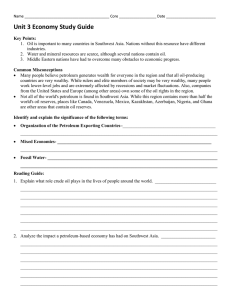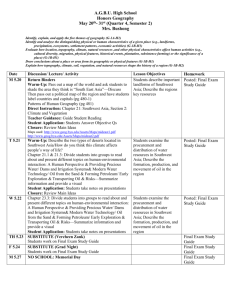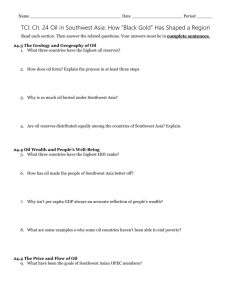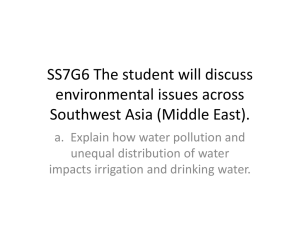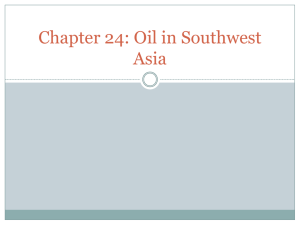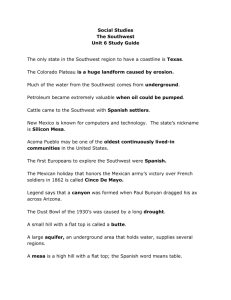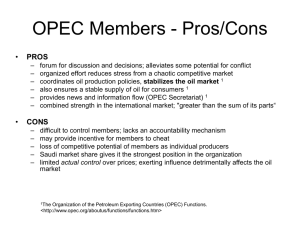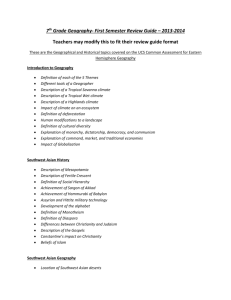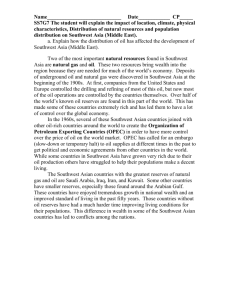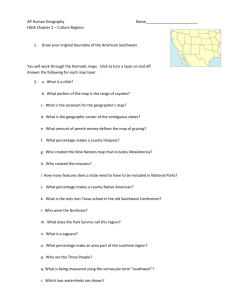SW Asia/ME Human Environment Interaction: Geography Grade 7
advertisement
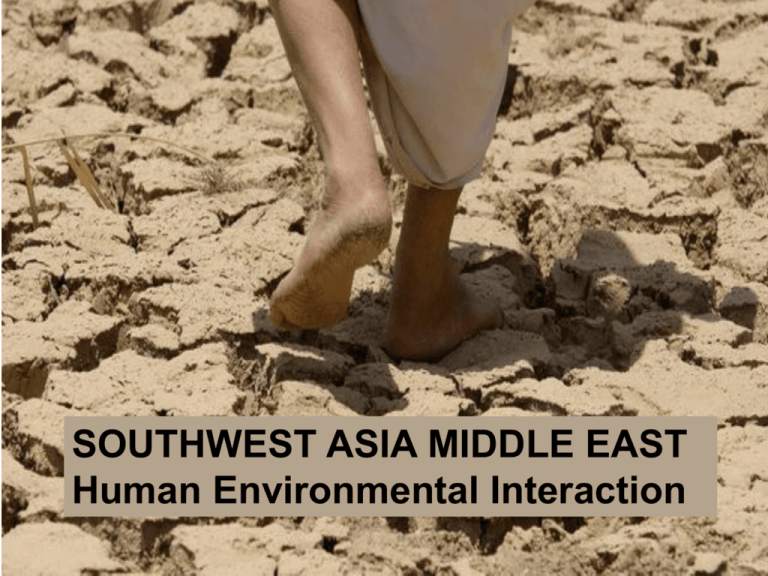
SOUTHWEST ASIA MIDDLE EAST Human Environmental Interaction GA Geography Grade 7 • As many of you learned in our introductory “Themes and Enduring Understandings” lessons for GA Geography Grade 7, students continue the study of physical and cultural geography, focusing on the remaining regions of the world (not covered last year): Southwest Asia/Middle East, Africa, and Southern and Eastern Asia. • For this lesson on SW Asia/ME Human Environmental Interaction, terms in bold text will be used to activate your schema of terms used last year. Many of these first terms relating to Human Environment Interaction should be familiar, as you applied them in both Geography and Earth Science last year. • I have links to web pages highlighted within the directions on slides as a reading exercise, and as a beginner lesson in technology. Assignment: Journal p 14 G6a G7a G7b SWA/ME Environment PPT • Use your journal to complete short answer responses to bold questions 1-10 and the BONUS. Skip a line between questions. Human Environmental Interaction SW Asia (ME) GA Standards SS7G6 The student will discuss environmental issues across Southwest Asia (Middle East) a. Explain how water pollution and the unequal distribution of water impacts irrigation and drinking water. SS7G7 The student will explain the impact of location, climate, physical characteristics, distribution of natural resources, and population distribution in Southwest Asia (Middle East) a. Explain how the distribution of oil has affected the development of Southwest Asia (Middle East) b. Explain how the deserts and rivers of Southwest Asia (Middle East) have affected the population in terms of where people live, the type of work they do, and how they travel. SW Asia/ME Environmental Issues Intro Fragile Environment Deforestation Desertification Overgrazing Water Management Pollution Review SW Asia/Middle East Political Features SS7G5a Turkey Iraq Iran Afghanistan Israel Saudi Arabia Click here for online map practice—or timed challenge Review SW Asia/Middle East Physical Features SS7G5b Gaza Strip Jordan River Suez Canal Red Sea Euphrates River Tigris River Persian Sea Strait of Hormuz Arabian Sea Click here for online practice Find SW Asia/ME. 1. What classification(s) defines most of SW Asia climates? 2.What classification defines our region of Southwest GA? 3. Use two sentences to respond to the question: How could the population density of SW Asia/ME be described using the map key of this graphic? 4. Use two sentences to respond to the question: How are physical features of the land a factor impacting (changing) how people live in SW Asia/ME? (Conservation—using techniques that make the best use of resources with the least amount of waste, loss, injury or decay) 5. In what way is this person practicing good conservation techniques? Subsistence Agriculture (Subsistence Farming) Nearly all the crops or livestock made are used to feed the family, with little extra; most are farms tended with hand tools and possibly an animal for plowing. 6. Use one to two sentences to respond to the question: What is meant by this statement— subsistence farmers are attempting to meet the basic survival needs of a family? 7. About what temperature range was recorded around the Persian Gulf on 21 Aug 2012? SE Asia ME Water Crisis Causes • Dry Land • Dams decreasing available water downstream • Drought (Little Rainfall) • Population Growth • Water use per person • Agriculture (Farming and Irrigation) • Overuse of land and fertilizers, leading to Desertification Solutions • Desalination Removing Salt from Seawater—Expensive! • Alternative Water Sources (Storing rainwater, capturing winter thaw from mountains etc.) • Importing Water (Buying from another country) • Conservation (Saving Water) • Treating Waste Water (Yummy) • Decreasing chemical fertilizers • Water resource distribution • Alternative Energy Sources Drought Extended period of time without rainfall Much of SW Asia/ME— arid or semi-arid with few water sources 8. Do you think the people in this picture were offered any payment for our opportunity to see into their culture (way of life of a group of people)? 9. Should they have been? Link to an Aquifer Recharge Map Series to answer the following: BONUS: Which region has a higher rate of aquifer recharge, southwest GA, USA, or SW Asia/Middle East? An oasis—a small place where trees are able to grow and where people can live with grazing animals and a few crops 10. In which of these two countries, Turkey or Saudi Arabia, would an oasis more likely be found? Water is unevenly distributed in SW Asia/Middle East, with much of the land being arid. Lack of water and WATER RIGHTS may lead to WATER WARS in the future. Countries like Turkey that place dams upstream decrease the water supply to others countries in desperate need. People are often displaced from their homelands. Conflict over water rights has also been an issue between the Jews and Arabs from the beginning of the Arab-Israeli Conflict. Water is expected to become the most valuable resource of SW Asia, taking the place of oil. Click on the interactive map link. Map of UN Partition Plan 1947 for dividing the land of Palestine between Palestinian and Jewish people DAMS Turkey, Syria, Iraq, & Iran Hydroelectric Power—from energy of moving water Industry Irrigation of crops Dams decrease the water supply, preventing rivers like the Tigris and Euphrates from flooding—nutrients no longer deposit on the soil as fertilizers—many farmers then use chemical fertilizers that eventually build up in the soil as salts---soil becomes unusable for crops or animals Efficient Wasteful WATER CONSERVATION ISSUES Drip Irrigation (Bringing water to plants where needed) Fossil Water (Paleowater) Water that has been sealed in underground aquifers (layers of rock) for long periods of time—once used cannot be replaced by underground springs or rainfall (a nonrenewable resource) Also, radioactive particles (from the breakdown of sandstone) have been found in some of the water—these particles must be removed and safely disposed of. Does this look like an inexpensive or a long-term solution to water needs? Pipes are put in place for a Libyan water transfer project. Link to fossil water article SALINATION—Water or land may become saturated with salt (also from overuse of fertilizers that leave salts in the soil that lead to an increase in deserts—desertification) With so many people living on the coasts because of arid land in the interior, salt water moves into well water making it brackish (fresh water mixes with salt water). Desalination plant in Saudi Arabia Produces 25,000,000 or more gal/day fresh water Some processes fit for drinking Desalination—Removes salt from seawater Problem—A technology too expensive for most to afford US has plants in Tampa Bay, FL and San Antonio, TX Petroleum—Crude Oil • Another resource unequally distributed in SW Asia/ME • Countries with oil have greater access to resources and development • Many countries have large populations living in poverty who suffer from the lack of resources Petroleum—an oily liquid that can be refined into gasoline and other fuels and oils— literally means “rock oil” of “oil form the earth” • It was discovered in Iran in 1908 and a lot more was found on the Arabian Peninsula and around the Persian Gulf in the 1930’s. • The Middle East became extremely important as well as increasingly wealthy, especially as they gradually took control of the oil production for foreign entities. • Crude oil gets drilled up from the ground and is transported either to refineries or to tankers. • The refineries refine the oil into other products, e.g. gasoline, kerosene, diesel, and others. • The oil tankers transport the oil from SW Asia to other places, such as Texas City. PETROLEUM—CRUDE OIL OPEC Organization of Petroleum Exporting Countries OPEC was formed by oil producing nations of the world as an international confederation for influencing the price of oil in world markets through control of the supply. What information does the graphic show? Create notes that list the members and crude oil reserve percentages for each country. Which four members have the largest reserves? Read more about the organization, members and mission of OPEC. Supertankers Knock Nevis • 1504 feet long, 226 feet wide • sits 80 feet in the water fully loaded • weighs 1,428,496,250 pounds • can carry 127,100,000 gallons of oil • so big, she can’t navigate the Panama Canal, the Suez Canal, or even the English Channel Oil spill of the Exxon Valdez in 1989 Plate Tectonics impacting the SW Asia/ME region Plate Tectonics impacting the SW Asia/ME region To answer the question, “How often do earthquakes occur in the region?,” click on the Seismic Monitor image or here to link to an interactive map. To complete overview and review SW Asia/Middle East click here Resources SW Asia/Middle East Human Environmental Interaction Fossil Water http://news.nationalgeographic.com/news/2010/05/100505-fossil-waterradioactive-science-environment/ World's Freshwater http://ngm.nationalgeographic.com/2010/04/water/water-animation http://www.aljazeera.com/indepth/features/2011/06/2011622193147231653.ht ml OPEC http://www.opec.org/opec_web/en/17.htm Earthquakes and volcanic activity http://www.iris.edu/seismon/ Map Practicehttp://www.mapquiz.net/en/ http://www.ilike2learn.com/ http://www.sheppardsoftware.com/Geography.htm http://www.studentsoftheworld.info/menu_infopays.html http://www.nationsonline.org/oneworld/western_asia_map.htm
